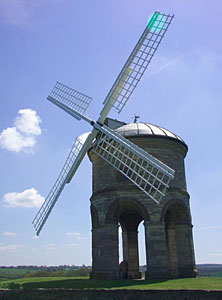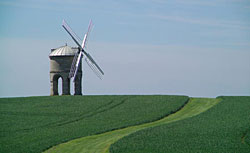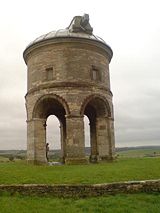

 The Windmill seen in our poster for Man of La Mancha is a real standing structure in Chesterton England. Windmills are much more common in the east of England, where they take advantage of the stiff easterly breezes that blow across Lincolnshire and East Anglia, than in the west. But travellers along the Fosse Way, the Roman road that connects Cirencester in Gloucestershire with Lincoln, are used to seeing one windmill on a hilltop at Chesterton in Warwickshire. It’s one of the most striking mills in England, making a strong silhouette that’s visible for miles around. The Windmill seen in our poster for Man of La Mancha is a real standing structure in Chesterton England. Windmills are much more common in the east of England, where they take advantage of the stiff easterly breezes that blow across Lincolnshire and East Anglia, than in the west. But travellers along the Fosse Way, the Roman road that connects Cirencester in Gloucestershire with Lincoln, are used to seeing one windmill on a hilltop at Chesterton in Warwickshire. It’s one of the most striking mills in England, making a strong silhouette that’s visible for miles around.
Most windmills were built without the help of an architect. They were put up by builders or millwrights who knew how to construct a piece of machinery that worked efficiently and weren’t much interested in architectural airs and graces. But Chesterton Windmill, which was built in 1632, is very unusual because it was obviously built to the designs of an architect who had imbibed the influence of the Classical style. It was one of those buildings that people used to attribute to the great Classical architect Inigo Jones, though there’s no evidence that Jones designed it. A more likely candidate is Jones’s pupil John Stone, who worked on the manor house nearby.
 The other odd thing about the mill is that the man who probably commissioned it, local grandee Sir Edward Peyto, was an astrologer and astronomer, and there’s a tradition that the building was originally an observatory that he used to look at the stars – presumably the rotating top, turned by means of a hand winch, housed Peyto’s telescope. If so, it was probably converted to milling quite early in its history, with added sails covered in sailcloth that cost 9 old pence per yard. It's very windy on top of this Warwickshire hill and Chesterton Windmill harnessed this energy to grind corn until around 1910, and was restored in 1969. The other odd thing about the mill is that the man who probably commissioned it, local grandee Sir Edward Peyto, was an astrologer and astronomer, and there’s a tradition that the building was originally an observatory that he used to look at the stars – presumably the rotating top, turned by means of a hand winch, housed Peyto’s telescope. If so, it was probably converted to milling quite early in its history, with added sails covered in sailcloth that cost 9 old pence per yard. It's very windy on top of this Warwickshire hill and Chesterton Windmill harnessed this energy to grind corn until around 1910, and was restored in 1969.
Construction
It is built of hard local limestone, with sandstone detailing. The mill tower, unique worldwide in structure and mechanics, is supported on six semicircular arches, on piers, the outer faces of which are arcs of circles radiating from a common centre. A sandstone string course surmounts the six arches and runs round the Tower, below the windows. There are four windows in the tower, two small and two much larger with stone mullioned windows. A small window set in the roof on the opposite side to the sails, has a small plaque above it with the letters "E. P. 1632".
Workings
Beside the open ground floor within the arches there are two more floors to the mill, the first, lower, or stone floor 15-foot (4.6 m) above ground level, housing millstones, great spur wheel, hurst frame, sack hoist rope passing through the floor trap, and the upper, second, or hoist floor with brake wheel, main gearing (wallover), sack hoist pulley, and parts of the winding winch. The windshaft and the main parts of the winding system including the wind direction inidicator is installed within the cap. The space inside the arches, until 1930, used to have a wooden structure to store the grain, and an open timber staircase to reach the milling floors. This structure was removed to prevent vandalism. The cap of the mill is a shallow dome which used to be covered with lead sheet, but also because of vandalism is now covered with aluminium. Between the cap and the top of the wall is a system of rollers running in a track plate allowing the cap to be rotated easily. There is a wind direction inidicator on the roof which is continued into the interior, and a small repeat indicator at its lower end, so that the miller could set the mill without leaving his work. The lattice-type-sails are 60 feet (18 m) span counter clock-wise rotation (seen from outside the mill; most of all windmills worldwide rotate clockwise seen from inside the mill - from "under the wind") and with 450 sq ft (42 m²) of canvas. The arched tower covers a very small diameter of 22 feet 9 inches (6.9 m) and it has an unusual "in cap" winding gear for an English windmill, the cap being winded by a hand operated winch having spur and worm gears.
Restoration
 |
The mill without its sails |
It seems the mill has undergone three major reconstructions, one in 1776 when the mill shaft was modified, and the date carved in the tail of the shaft, and one in 1860 when the old curb and cap framing was altered. By 1910 it had ceased to function as a mill because the winding gear failed to operate, so that her last miller, William Haynes, was no longer able to turn the mill's cap round to make the sails face the wind. He abandoned the mill and moved to another mill nearby. It was not until 1969 that reconstruction of Chesterton Mill began again. The windmill repairs were finished in 1971, and the mill reopened for a few days to the public each year (volunteers from nearby villages help run the open days and provide stewards for the event).
In 1975 it was awarded one of the Civic Trust Heritage Awards, and the mill's status is reflected in the name of the nearby Leamington Football Club ground the New Windmill.
A stone tower similar to Chesterton Windmill exists in Newport, RI, U.S.A. The commonly accepted theory is that it was built by Benedict Arnold around 1676 after a previous wooden mill was blown down in 1675. It is not quite the same as Chesterton Windmill, having eight round pillars, but it was very similar. The Arnold family, whose place of origin is disputed but may have been either Leamington [1] or further down the Fosse Way, near Ilchester in Somerset, emigrated to Rhode Island in 1635 where Benedict became governor in 1663. This has led to speculation that the Newport Tower was based on Chesterton Windmill. However, some historians, as well as amateur researchers, dispute this theory and have claimed that it is several centuries older, thus being evidence of a pre-Columbian (Viking) settlement in New England.
For more about the history of this building, go here.
|



